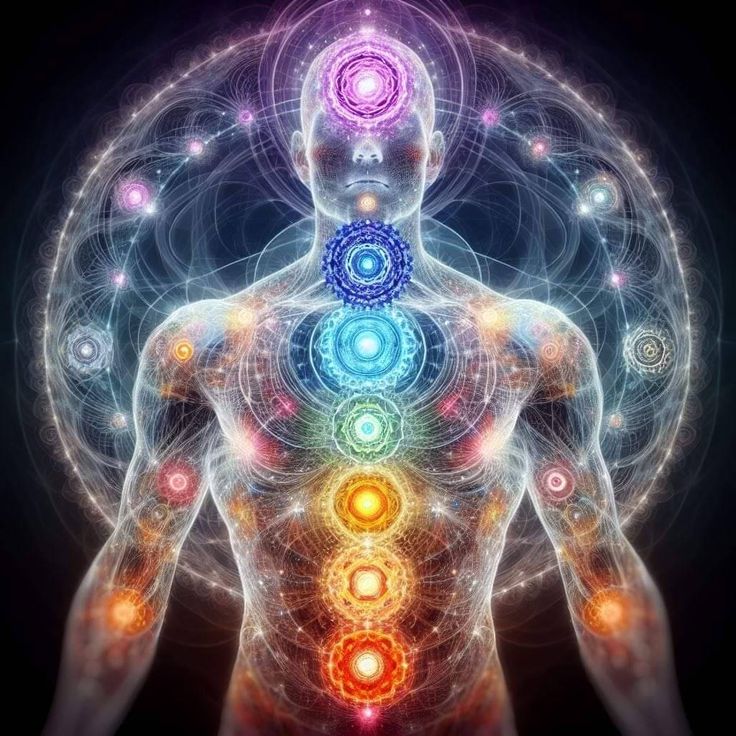The chakras are energy centers in the body, originating from ancient Indian traditions. There are seven primary chakras, each associated with specific physical, emotional, and spiritual aspects. Here’s a breakdown:
1. Root Chakra (Muladhara)

- Location: Base of the spine (tailbone)
- Color: Red
- Element: Earth
- Function: Stability, security, and grounding.
- Associated with: Basic needs, survival instincts, physical identity, and financial independence.
- Signs of Imbalance: Feelings of insecurity, fear, instability, or financial stress. Physical symptoms may include fatigue or issues with the legs, feet, or lower back.
2. Sacral Chakra (Svadhisthana)

- Location: Lower abdomen (just below the navel)
- Color: Orange
- Element: Water
- Function: Creativity, pleasure, and emotional expression.
- Associated with: Sexuality, emotional well-being, and creative energy.
- Signs of Imbalance: Emotional instability, lack of passion or creativity, sexual dysfunction, or guilt. Physical symptoms may include issues with reproductive organs, kidneys, or bladder.
3. Solar Plexus Chakra (Manipura)

- Location: Upper abdomen (stomach area)
- Color: Yellow
- Element: Fire
- Function: Personal power, confidence, and self-esteem.
- Associated with: Willpower, independence, and decision-making.
- Signs of Imbalance: Low self-esteem, feelings of powerlessness, or aggression. Physical symptoms may include digestive problems or issues with the liver or pancreas.
4. Heart Chakra (Anahata)

- Location: Center of the chest (over the heart)
- Color: Green
- Element: Air
- Function: Love, compassion, and connection.
- Associated with: Forgiveness, empathy, and harmonious relationships.
- Signs of Imbalance: Difficulty trusting, feelings of loneliness or resentment, or an inability to forgive. Physical symptoms may include heart or lung issues.
5. Throat Chakra (Vishuddha)

- Location: Throat
- Color: Blue
- Element: Ether (Space)
- Function: Communication, self-expression, and truth.
- Associated with: Speaking one’s truth, effective communication, and self-expression.
- Signs of Imbalance: Difficulty expressing oneself, fear of speaking, or dishonesty. Physical symptoms may include throat, neck, or thyroid problems.
6. Third Eye Chakra (Ajna)

- Location: Forehead, between the eyebrows
- Color: Indigo
- Element: Light
- Function: Intuition, wisdom, and insight.
- Associated with: Inner vision, imagination, and clarity of thought.
- Signs of Imbalance: Confusion, lack of focus, or disconnection from intuition. Physical symptoms may include headaches, vision problems, or insomnia.
7. Crown Chakra (Sahasrara)

- Location: Top of the head
- Color: Violet or White
- Element: Cosmic Energy
- Function: Spiritual connection and enlightenment.
- Associated with: Higher consciousness, universal awareness, and inner peace.
- Signs of Imbalance: Disconnection from spirituality, lack of purpose, or feeling isolated. Physical symptoms may include neurological issues or chronic fatigue.
Balancing Chakras:
- Meditation: Focusing on each chakra’s color or mantra.
- Yoga: Poses that align with the energy centers.
- Crystals: Using stones associated with each chakra.
- Sound Therapy: Listening to frequencies or chants tied to specific chakras.
- Healing Practices: Reiki, acupuncture, or energy work.
When all chakras are balanced, energy flows freely, promoting overall well-being and harmony.

